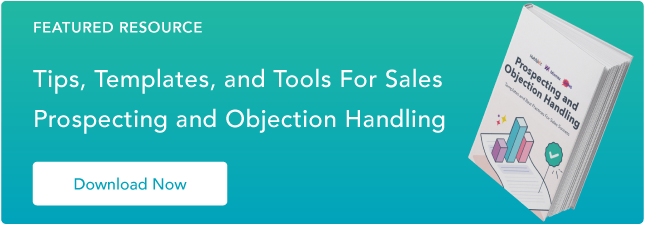Salespeople need to be able to neutralize and move past buyer objections to be successful, but there's a distinction between objections and brush-offs. An objection is a legitimate concern that could threaten a deal, while a brush-off comes from a less genuine place — it's a knee-jerk reaction prospects raise when they want to quickly and abruptly end a sales call.

Brush-offs are time savers — ways for prospects to get you off their back without much regard for what you‘re selling or how you’re selling it. And if you want to consistently engage in meaningful conversations with prospects, you need to know how to work past them.
That means learning to be disruptive. If you offer up a traditional, more passive response, your buyer will continue on autopilot — not even giving you a second thought when the call ends. Dare to be different. When you hear the following five prospecting brush-offs, use these responses to break the prospect’s trance and get them to truly tune into what you’re saying.
5 Typical Brush-Offs and How to Respond to Them
1. “I don’t have time for this right now.”
Prospects are busy, and your call is undoubtedly interrupting their work. Who likes to be interrupted? No one. So don’t be surprised when you hear a hasty “Now’s not a good time,” as soon as the buyer realizes this is a sales call.
Most salespeople will then apologize and ask, “When would be a better time?” The prospect automatically replies next month, quarter, or year — any day that’s not today. But as sales reps well know, a successful call ends with a concrete calendar meeting, not a vague “Let’s talk later.”
So how can salespeople turn this brush-off into a meeting with a specific date and time? It’s incredibly easy.
Don’t say anything.
That’s right. When you hear this brush-off, simply fall silent. After a few seconds of silence, the prospect will feel uncomfortable and ask, “Are you still there?” Then the salesperson can respond with, “Yes, I’m here. I thought you were looking at your calendar for a better time to talk.”
What a disarming reply! It catches them off-guard — and they often wind up actually offering up a day and time that works better as a result. Meeting booked, and attention earned.
2. “I’m not the right person.”
Prospecting isn’t a perfect science, so it’s likely that the first person you call upon won’t be the decision-maker. No problem — all you have to do is ask the person you’re on the phone with who the right contact is.
Easier said than done. Prospects often fire off “I’m not the right person” or “That’s a different department” and then mentally check out. They don’t owe you anything, so why would they point you in the right direction?
If a sales rep immediately asks, “Who should I talk to?”, most prospects will counter with something like, “Just send me some information and I’ll forward it along.” Dead end.
Here’s a better exchange:
Prospect: “I’m not the right person.”
Salesperson: “Well let me ask you this — where should I go to get better educated on your company?”
Prospect: “Well … there’s a section on our website with information for vendors.”
Salesperson: “So I can get there right from your homepage?”
Prospect: “That’s right.”
Salesperson: “Let me see if I can find it while I have you here. Is ‘Vendor 101’ the right page?”
Prospect: “Yes, that’s the correct one.”
Salesperson: “And after I do the research, who should I ask for?”
You still ask for a referral — you just don’t do it right off the bat. Instead, engage the prospect on another topic before you swoop in with the ask. The contact is much more likely to point you in the right direction if you warm them up a bit first.
3. “I’ve already looked at your company, and we weren’t interested.”
Most salespeople take this statement to mean that the prospect isn’t a good fit. They’ve already disqualified themselves — time to move on to the next opportunity.
Not so fast. Rather than asking if anything has changed in the meantime or thanking them for their time and ending the call, try this approach instead:
Prospect: “We already looked at you guys last month and didn’t think it was the right choice.”
Salesperson: “Well, if you looked at us last month and crossed us off, that was probably the right decision.”
[Pause]
Salesperson: “But I’ve never spoken to you before, and the good news is I’ll know in five minutes if anything has changed that’s worthy of a phone call from us. Do you have five minutes?”
Prospect: “Sure.”
You never want to argue with the prospect’s ability to make a decision. Don’t tell them they made a mistake — instead, focus on the future and pose a few quick qualifying questions. This way, if you discover that the company could, in fact, benefit from your product or service, you can re-engage the decision-maker without making them feel dumb.
4. “Can you just send me some information?”
Salespeople live to serve their prospects and clients, so when they hear this question, they immediately jump to fulfill the request. However, merely sending content doesn’t get a meeting booked, which is often the goal of a prospecting call.
With this in mind, don’t respond to this brush-off with, “Of course, what would you like me to send you?”
Instead, say the following:
“Sure thing. I will call you tomorrow to get your feedback on what I’ve sent you. If I call you tomorrow, will you take my call?”
If the prospect says they will, you’ve secured a commitment from them — a small close that paves the way for the ultimate close.
5. “We already use something for that.”
A close relative of number three on this list, reps tend to respond to the news that a prospect already uses a competitive product in one of two ways:
- “Oh, okay. So how is that going for you?”
- “Don't you get frustrated that Vendor Y can't do X? We've had a lot of people leave them for us ... ”
Both of these responses are problematic. The first usually prompts the prospect to talk about their current vendor in a positive light — “It's going fine, thanks.” The second challenges the prospect's decision, and puts them on the defensive.
Keep in mind, it‘s rare for a business leader to go back and re-investigate an old problem if they’ve already implemented a solution — whether it's a perfect fit or not. Organizations have no shortage of problems to fix, and chances are, your decision maker has moved on to the next one after they signed with your competitor.
So instead of asking the prospect about the relationship with your rival vendor or trying to create some doubt around their decision, simply say:
“Okay. Well if you've already got a solution in-house that's working for you, you probably don't need us.”
Buyers are prepared to answer a salesperson‘s rebuttals, but a simple statement of acceptance is far more disarming — and throws them for a loop about how to reply. At this point, they’ll either end the call and hang up the phone, confirming that they're satisfied with their vendor and freeing up your time to pursue a new opportunity or fall silent.
Here's your chance.
If they're still on the line after four seconds of silence, follow up with:
“Let me ask you — are you currently under contract with Vendor X?”
This response not only relieves the tension of the silence, but it also lets the prospect know that you‘re not going to attack their decision — you’d simply like to gather some more information.
The buyer will then reveal that they are indeed locked into a long-term contract (disqualify and move on), say they‘re not under contract or that it expires soon (recognize the opening, and jump on it), or admit that they’re not sure (ask who would know).
There are no magic words to get someone to talk to you. However, when used correctly, these responses can help you get around a good number of the brush-offs you encounter — and neutralizing brush-offs is the first step to engagement, and ultimately, sales.











